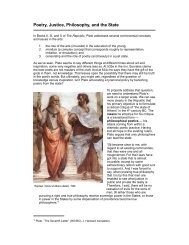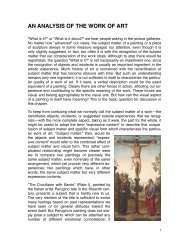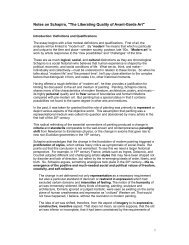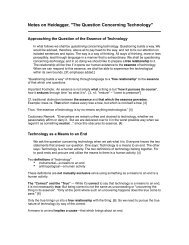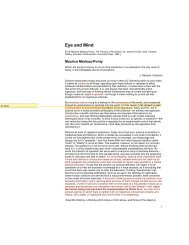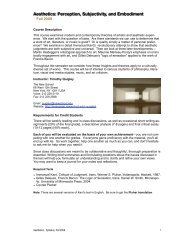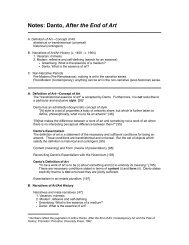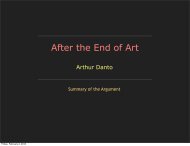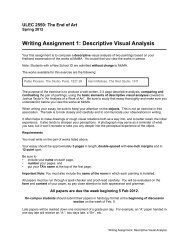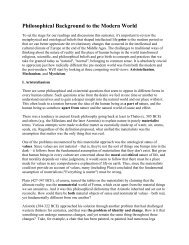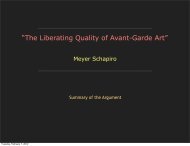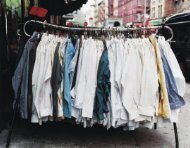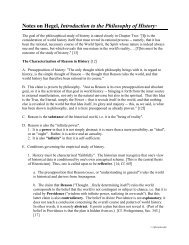The Art of Romare Bearden - Timothy R. Quigley
The Art of Romare Bearden - Timothy R. Quigley
The Art of Romare Bearden - Timothy R. Quigley
Create successful ePaper yourself
Turn your PDF publications into a flip-book with our unique Google optimized e-Paper software.
<strong>The</strong> MassachusettsReviewsuch early masters as Giotto and de Hooch. That he went on tobecome fascinated with the possibilities lying in such "found" materials is both an important illustrative instance for younger paintersand a source for our delight and wonder.<strong>Bearden</strong> knows that regardless <strong>of</strong> the individual painter's personalhistory, taste or point <strong>of</strong> view, he must, nevertheless, pay his materials the respect <strong>of</strong> approaching them through a highly consciousawareness <strong>of</strong> the resources and limitations <strong>of</strong> the form to which hehas dedicated his creative energies. One suspects also that as anartist possessing a marked gift for pedagogy, he has sought here toreveal a world long hidden by the cliches <strong>of</strong> sociology and renderedcloudy by the distortions <strong>of</strong> newsprint and the false continuity imposed upon our conception <strong>of</strong> Negro life by television and muchdocumentary photography. <strong>The</strong>refore, as he delights us with themagic <strong>of</strong> design and teaches us the ambiguity <strong>of</strong> vision, <strong>Bearden</strong>insists that we see and that we see in depth and by the fresh light<strong>of</strong> the creative vision. <strong>Bearden</strong> knows that the true complexity <strong>of</strong> theslum dweller and the tenant farmer require a release from theprison <strong>of</strong> our media-dulled perception and a reassembling in formswhich would convey something <strong>of</strong> the depth and wonder <strong>of</strong> theNegro American's stubborn humanity.Being aware that the true artist destroys the accepted world byway <strong>of</strong> revealing the unseen, and creating that which is new anduniquely his own, <strong>Bearden</strong> has used cubist techniques to his owningenious effect. His mask-faced Harlemites and tenant farmers setin their mysterious, familiar, but emphatically abstract, scenes arenevertheless resonant <strong>of</strong> artistic and social history. Without compromising their integrity as elements in plastic compositions hisfigures are eloquent <strong>of</strong> a complex reality lying beyond their frames.While functioning as integral elements <strong>of</strong> design they serve simultaneously as signs and symbols <strong>of</strong> a humanity which has struggledto survive the decimating and fragmentizing effects <strong>of</strong> Americansocial processes. Here faces which draw upon the abstract character<strong>of</strong> African sculpture for their composition are made to focus ourattention upon the far from abstract reality <strong>of</strong> a people. Here abstract interiors are presented in which concrete life is acted outunder repressive conditions. Here, too, the poetry <strong>of</strong> the blues isprojected through synthetic forms which, visually, are in themselvestragi-comic and eloquently poetic. A harsh poetry this, but poetrynevertheless; with the nostalgic imagery <strong>of</strong> the blues conceived asvisual form, image, pattern and symbol?including the familiar trains(evoking partings and reconciliations), and the conjur women (whoappear in these works with the ubiquity <strong>of</strong> the witches who haunt thedrawing <strong>of</strong> Goya) who evoke the abiding mystery <strong>of</strong> the enigmatic678



